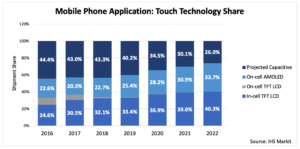In a new blog post, IHS Markit’s Calvin Hsieh has revealed that all of this year’s new iPhone models feature the GF2 touch sensor structure already in use in Apple’s iPad series. Also known as double-sided indium tin oxide (DITO) film, GF2 relies on touch sensor patterning on the top and bottom sides of the film substrate.
Apple used in-cell touch LCD displays for five years until 2017. However, while the new iPhone XR has an LCD display, it still uses GF2. Apple’s reliance on GF2 in new iPhone models will halt the decline in projected capacitive touch display shipments. Capacitive touch displays, which made up 43% of the market in 2017, are expected to increase slightly to 43.3% in 2018, according to IHS data.

Previously, the iPhone’s touch sensor structure relied on a glass-glass (GG) structure, which features an additional glass substrate with touch sensors on the top and bottom. Apple next developed an in-cell touch sensor structure and applied it to the iPhone 5 in 2012 because in-cell touch offers better display transmittance and thickness.
Before iPhone X, all iPhone models adopted the proprietary in-cell touch TFT LCD, which accounted for 13.3% of all touch-display shipments in 2017. The iPhone X was the first smartphone to adopt GF2. The new models have followed suit, causing GF2’s shipment share to rise from 3.6% in 2017 to 8.6% in 2018.
However, Apple’s GF2 transition will likely be temporary. Although GF2 has a mature supply chain, including film substrate, sensor patterning and touch module bonding, its thickness and display transmittance means Apple will not adopt it in the long term, Hsieh said. While Apple establishes its own AMOLED supply chain for iPhones, selecting GF2 could cause panel-makers, aside from Samsung Display, to quickly increase their yield rates.
Once Apple has more AMOLED display sources, the customisation of the company’s proprietary touch sensor structure will be almost inevitable. Apple previously did so in 2012, with customised in-cell TFT LCD displays, and IHS Markit expects that the company will do the same thing with AMOLED.

